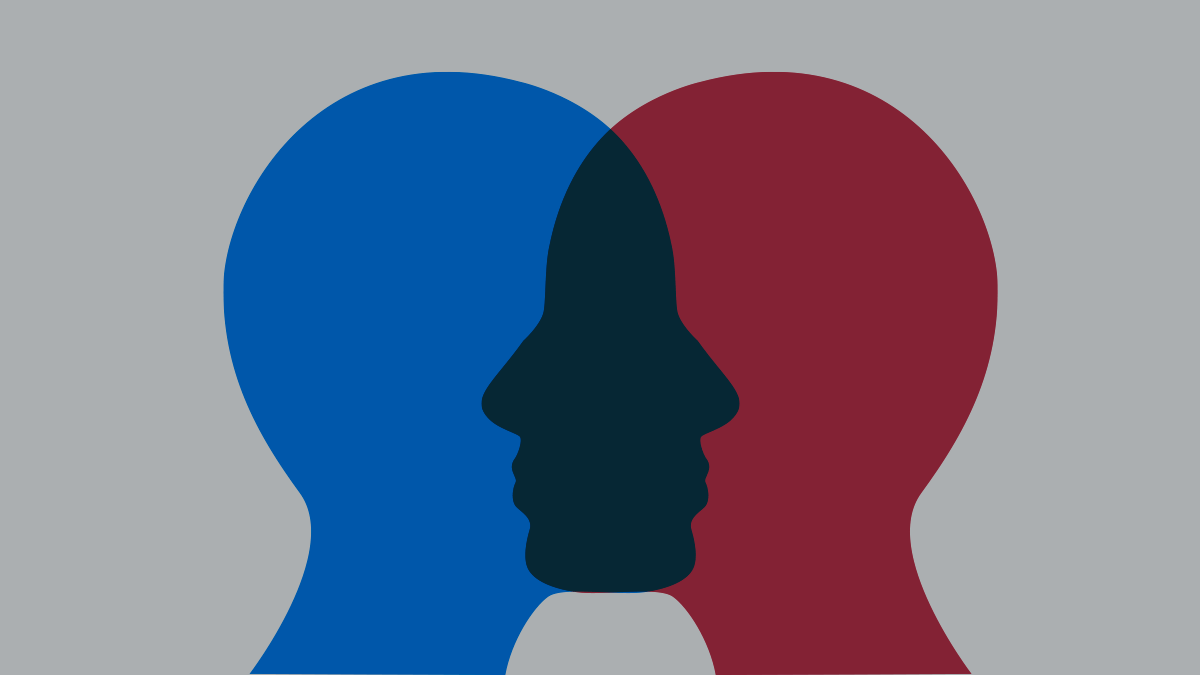Using empathy for your design
Author
Barbara Werdmuller
Published
13 October 2020
Reading time
10 minutes
As a designer you want to understand your users in order to be able to make good design decisions. Empathy seems to be the key to this. But do you really open the right door or do you fall into a deep trap?
In this post I share what I encountered in my search for an answer to this question. Dive into the world of psychology, political philosophy and UX. And be inspired by insights from Paul Bloom, John Rawls, Mike Monteiro and the experiences of fellow designers. Maybe you will look at empathy differently like me.
1. The pitfall of empathy
Can you be against empathy? Yes, that’s possible. Paul Bloom published a high-profile bestseller on this topic in 2016: Against empathy: The Case for Rational Compassion. The book is interesting reading for designers and non-designers, because it makes you aware that empathy has limitations and can even do more harm than good.
Without empathy our decisions would be clearer, fairer, and ultimately more moral.
Paul Bloom
Psychologist Paul Bloom opens his book with an event that shocked the US in 2012: the shooting at the Sandy Hook Elementary School in Newtown. In addition, 26 people died, including 20 children. Paul Bloom wonders why that event shocked him and those close to him so much and is still so sharp in his retina. And why Newtown was inundated with so much charity that the (well-to-do) residents experienced it as a burden.
The toll of mass shootings is relatively low: less than 0.1% of American murders. In 2012, more children were killed in domestic violence in Chicago than in Newtown. Why didn’t Paul Bloom worry about that for a moment? His explanation: The shooting in Sandy Hook was a striking event, but also one where he (young father, white, living near Newtown) felt a lot of empathy for the parents, teachers and children. More than for black teens in a disadvantaged Chicago neighborhood.
Given the title of the book, you might think that this introduction is the start of a ruthless attack on empathy. But Paul Bloom mainly focuses his arrows on emotional empathy (feeling, ‘the act to experience the world as you think someone else does‘) and not on rational empathy (understanding, ‘understand the mind or others ‘). He also sees that empathy is important in relationships, art, sports, etc. But he does not think empathy is a good basis for decision-making.
Decision-making and empathy
In short, Paul Bloom sees empathy as a spotlight, showing where attention and help is needed. But a spotlight has a focus, and that’s exactly the weakness of empathy. Empathy is:
- Selective: it is impossible to empathize with everyone. A well-known phenomenon is the ‘identifiable victim effect‘. People provide more help when faced with an identifiable person in need than with a large, abstract group with the same need.
- Bias: it is easier to put yourself in the shoes of people who are close to or look like you. See the example from Sandy Hook. Empathy can also be misused to incite hatred between groups or violence.
- Not well thought out/erratic: with empathy, (expected) costs and benefits are not weighed up. Charity motivated by empathy can be negative because of this. Designer Maike Klip describes an example in her blog (in Dutch): volunteer projects in developing countries that are good for volunteers, but not for the local population.
In short, according to Paul Bloom, empathy can have ‘perverse’ consequences, such as unequal treatment, mismanagement, division and even war. He is, however, an advocate of ‘rational compassion’: having an eye for others, making an effort to improve lives, using your head instead of your heart. But how can you arrive at well-considered, rational decisions without (unconscious) prejudices? According to Paul Bloom, the “veil of ignorance” is a useful tool.
2. The power of ignorance
In the past centuries, many great thinkers have cracked their brains on the question of how to organize a just society. A well-known concept from political philosophy is the “veil of ignorance.” Designer Mike Monteiro sees this as an alternative to empathy in ethical design.
In short, a veil of ignorance is a way of determining whether something you’re making sucks by allowing that you may end up in any possible relationship to it.
Mike Monteiro
 Visualisation of the veil of ignorance (Dan Bollinger)
Visualisation of the veil of ignorance (Dan Bollinger)
One of the spiritual fathers of the ‘veil of ignorance’ is the American political philosopher John Rawls. He states that everyone views the world from within themselves. Our image of a just society is determined by who we are and our position: man, woman, poor, rich, highly educated, illiterate, healthy, disabled, etc. A single welfare mother probably has a different vision of the ideal tax system than a single banker.
But suppose we are allowed to organize a new society while we are blindfolded. When we don’t know who we will be and what position we will be in. According to John Rawls, behind such a veil of ignorance, we should not be guided by self-interest in our decisions. And a just society with opportunities for everyone will be reached.
Design with a veil
Designer Mike Monteiro (writer and speaker and well-known advocate of ethical design) makes a nice bridge to the work of designers. His thesis is: design is political. “Not only can a designer change the world, a designer should.” And the ‘veil of ignorance’ is the most important ‘political-ethical tool‘ in the designers toolbox. Our empathy is limited and does not extend beyond our experience, argues Mike Monteiro. By putting on a ‘veil of ignorance’, not knowing what our role and relationship would be with our design, we can get around this.
Mike Monteiro cites Uber as an example, the company that mediates between buyers and providers of passenger transport. The service that Uber offers is extremely popular and in itself not unethical. But there are clearly aspects that you can question, such as the poor position of drivers. Jeroen van Bergeijk does not paint a rosy picture of his experiences as an Uber driver in the Volkskrant (in Dutch): low pay versus long working hours, stress from bad customer ratings, an addictive app full of gamification (such as badges, challenges).
What would happen if the Uber designers put on the “veil of ignorance” and assume that they themselves are the passenger, the driver, the app administrator or the manager of Uber? According to Mike Monteiro, they would then develop a service that works out well for everyone involved. For example, with an app that does not take over the life of a driver.
Imagining that you are someone else
Designer Adam Morse takes inspiration from Mike Monteiro’s plea in a blogpost on designing for accessibility:
“When I sit down to design things I try to put on the veil of ignorance. I imagine a world where I am not who I am right now. And I think about all the things that could possibly frustrate me. Then I think some more. I try to design for that reality. I don’t design for myself and my perfect eyesight, my retina screens, and my fast internet connection.”
This quote contains an interesting contradiction. Adam Morse puts on a veil, imagines he is not who he is and thinks about what would frustrate him if he didn’t have a perfect view and a good screen. That sounds like empathy. Does it still have value? How do designers deal with empathy in practice?
3. Using empathy for your design
Lately a lot has been published about empathy and design. On the internet you can find countless blog posts and articles. The focus is often on the added value of empathy, but also on the pitfalls or on both. Below you can learn about the different visions and experiences of designers.
Empathy is a bridge into our user’s minds and our greatest asset as UX professionals.
Sarah Gibbons
 Spectrum of empathy (Norman Nielsen Group)
Spectrum of empathy (Norman Nielsen Group)
According to designer Sarah Gibbons (Nielsen Norman Group), empathy is essential in UX. As a designer, empathy allows you to understand the expectations, possibilities, goals and frustrations of users. Then you can (as Paul Bloom advocates) show compassion: come up with solutions that remove unnecessary obstacles and friction and thereby improve the lives of your users.
Putting empathy into practice requires a lot of effort. You have to put your ego and assumptions aside and immerse yourself in user research. Observing real users, capturing knowledge in empathy maps, investing in a diverse design team, and embedding empathy in design guidelines. Above all, you should put yourself in the shoes of your user: “Instead of just designing an accessible website, practicing empathy is using a screen reader, blindfolded, in order to complete a task on your own website.”
Empathy allows you to ignore the actual stated intentions and desires of the people that you are feeling empathy for.
Matt May

Tweet by Matt May
Matt May, Head of Inclusive Design at Adobe and speaker at Accessibility Scotland 2019, is critical of using empathy when you want to design accessible products. According to him, you should not ’empathize’, but ask users with a disability which solution they want. He also strongly believes in equality and sustainable participation, as interaction designer Marie van Driessche advocated in a tweet bepleit:
“It struck to me that I’m making things easy for designers without actually talking to me, or another deaf people/users. I’m often being asked afterwards to check their work but they should ask me during their process. Ask me to think and work with them‘.”
Human-centred design pioneer Donald A. Norman is also skeptical about the effectiveness of empathy in design, especially when you have to come up with solutions for communities: “We can’t get into the heads and minds of millions of people, more about we don’t have to: we simply have to understand what people are trying to do and then make it possible”. He believes more in a design tandem, in which designers purely facilitate and community experts bring in knowledge of the content.
The government must be radically empathetic.
Maike Klip
Dutch digital strategist and designer Maike Klip is researching for DUO (the Dutch Education Executive Agency) how the digital government can have an understanding connection with citizens. You can follow her research on her blog (in Dutch). She enters into extensive discussions with citizens and civil servants and empathises with this as much as possible. How do citizens experience the services of DUO? Do they feel understood? How do civil servants make choices and what role does understanding for citizens play in their work? She lets citizens fill cards, make videos about their lives and makes portraits of civil servants, which she shares at exhibitions.
Maike Klip is very aware of the limitations of empathy. “Empathy is arbitrary. And you want the government to be not arbitrary. Technology is not neutral. We subconsciously put our own assumptions into what we make.” Books such as Paul Bloom’s even have her for a moment doubting about the empathetic part in design. Shouldn’t the government ‘fix’ the system, so that arbitrariness disappears and empathy becomes superfluous? But to build that system you have to understand your users.
Her conclusion: the government must be radically empathetic. And the makers of the digital government are responsible for a good translation of empathy. Maike Klip and her colleagues try to centralize understanding for the citizen at DUO, with an eye for the pitfalls. For example, they look at how to better organise research (in Dutch), so that the organization makes decisions based on facts instead of assumptions. In this way, the government can gradually repay its empathy debt.
Engineer Lyle Mullican looks at the role of designer in a similar way to Maike Klip. He sees a designer as a ‘user advocate‘, who has to weigh up (sometimes conflicting) interests in design decisions, because: “An advocate exercises empathy not only on behalf of the user, but also on behalf of the business”.
Empathy is a strong engine in your design process.
Victor Visser
—
Service designer,
Informaat
Service designer Victor Visser (Informaat) designs for various organizations and strongly believes in the power of empathy.
He says: “In various design processes I have noticed that empathy can set a lot in motion. I therefore consciously use it. Think of videos that show how users with disabilities experience a service, where their frustrations about obstacles are razor-sharp. These can be real eye-openers, because stakeholders in an organization then understand and feel the impact of a service on users. This also creates support for change.
Another example: personas. If you create truthful personas, based on research and / or input from users, you literally and figuratively give the target group (s) a face. This evokes empathy. And that is a strong driver when you are going to set up a customer journey or brainstorm about design solutions with stakeholders.
Furthermore, I have good experiences with context mapping. This research method helps you develop empathy for your users. You involve users as experts at an early stage, immerse yourself in their daily experiences with your product or service and use techniques to identify latent needs. It is so much easier to design suitable solutions.
Of course, there is a risk that you will focus too much, make incorrect assumptions, or simplify. But as a good designer you are aware of this and you overcome this by also looking at the big picture and weighing interests. And especially by validating. You continuously test and adjust your designs among different user groups.
In my experience, when drawing up design patterns, the interests of users are central, not those of the company. In addition to ease of use, you also include other relevant values of the organization and users. Think of accessibility, privacy, sustainability. And you try to avoid dark patterns at all times.”
4. A veil with empathy for valuable solutions underneath
Practice shows that rational and emotional empathy is very valuable in the design process. There are certainly pitfalls, but as a designer you can avoid them. How does this relate to the “veil of ignorance” advocated by Mike Monteiro?  TrueX pyramid of values
TrueX pyramid of values
My conclusion of my search is that the ‘veil of ignorance’ and empathy are not mutually exclusive, but that the strength lies in the combination. You avoid a limited perspective in your design process and you build up understanding for the situation of users.
For example, if you are going to design for Uber, it makes sense to put on the ‘veil of ignorance’ first. Assume that you could be a rushed customer who wants to go to a business appointment quickly and comfortably on a sweltering summer day. But also be a poor taxi driver, who wants to make a lot of journeys because he needs money, but also wants a reasonable work-life balance and as little stress as possible when driving.
Then you apply empathy under your veil and empathize with that person to the maximum. What is it like as a customer without cooling off in a stuffy taxi that also makes a detour due to an input error? Or to be a taxi driver who is bombarded with bad ratings, badges and challenges all working day?
The challenge for you and your design team is then to investigate how you can prevent these situations. For example, as we do at Informaat, using a value pyramid to examine relevant values for your organization and users: ease of use and efficiency, but also ethical values such as sustainability, well-being or autonomy. This way you can turn empathy into compassion and develop valuable solutions that make the world a little more beautiful.
Tips for using empathy for your design
Harness the power of empathy.
- Use methods that help build empathy, such as context mapping, user journeys, personas, diaries, empathy maps, etc.
- Interview and observe users of your product or service.
- Show stakeholders and let them feel what users experience (through photos, videos or storytelling).
- Embed empathy in your design guidelines.
Avoid the pitfalls of empathy.
- Involve users early and sustainably in your design process.
- Invest in a diverse design team.
- Avoid simplification and base deliverables (personas, empathy maps, etc.) on solid research.
- Validate solutions under various types of user groups.
About the author

Barbara Werdmuller
Content designer
Design
UX
Empathy



